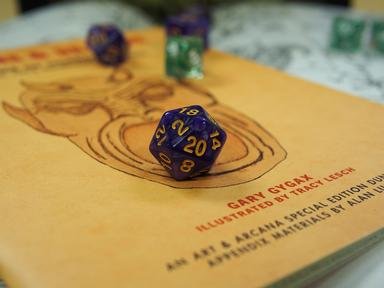Quiz Answer Key and Fun Facts
1. This set is for player characters who, after proving themselves worthy and completing many epic quests, have finally achieved immortality. While mortal characters in Dungeons & Dragons measure their advancement using experience points (XP), what do immortal characters use instead?
2. When a character becomes an immortal, they have a choice of appearing in any of three main forms. Which of the following is NOT the name of one of the three forms?
3. Like mortal characters, in Dungeons & Dragons, immortals have six ability scores - intelligence, strength, dexterity, constitution, wisdom, and charisma - each of which affects how well they function in some respect. What ability score determines the maximum number of projects an Immortal can handle at one time?
4. In addition to being able to engage in combat using physical or magical attacks like mortal characters, immortals also have the option of performing combat using Power. As well as using Power combat to reduce another character's Power points, it can be used to attack another's ability scores. Some ability attacks require only mental communication between the combatants, while others require physical contact. Which of the following abilities can only be attacked via physical contact?
5. Every immortal has a personal home plane, each of which is usually connected to the astral plane by a number of access points. The ruler of the home plane may increase or decrease the number of access points if they wish and may even remove all access points, causing it to apparently vanish from the astral plane. How can a plane with no astral access points be detected from the astral plane?
6. The Dungeon Master's Guide to Immortals describes many kinds of creatures that immortals might meet in their travels, especially in the astral plane. Some of these creatures were described in previous rules sets or earlier versions of Dungeons and Dragons, while some other were completely new. One of these is an awesome creature of enormous size that consists of a bulbous central node with 20 tubular strands projecting horizontally for miles from each of its left and right sides. What is this dreaded race called?
7. The Immortals Set describes two demon rulers by name, while noting that there are many others. One of them is called Orcus, who appears as a 15-foot-tall goat-like humanoid. The other, who appears as an 18-foot-tall reptilian monster with two monkey heads, tentacles for arms, and a forked tail, is known by what name?
8. In Dungeons & Dragons, mortal spellcasters who attempt to teleport from one place to another always have a risk of arriving in the wrong destination. However, immortals may teleport without error to or from any location within the same plane of existence. What reason is given in the Immortals Rules Set to explain this ability of immortal characters?
9. The Dungeon Master's Guide to Immortals presents a fantasy model of astronomy, should players wish to explore the physical universe. This includes an alternative version of the solar system in which the region between Mars and Jupiter is occupied by a doomed planet with what suggested name, inspired by an ancient Greek myth about a man with a sword hanging over his head?
10. In explaining the nature of the multiverse, The Dungeon Master's Guide to Immortals notes that there exists a "Dimensional Vortex" that the immortals are unable to pass beyond and which they do not understand, despite their great powers. Adding to the mystery, certain kinds of "vortex creatures" have been observed freely entering and leaving the Dimensional Vortex. Which of the following is one of these dangerous creatures?
Source: Author
agentofchaos
This quiz was reviewed by FunTrivia editor
WesleyCrusher before going online.
Any errors found in FunTrivia content are routinely corrected through our feedback system.
